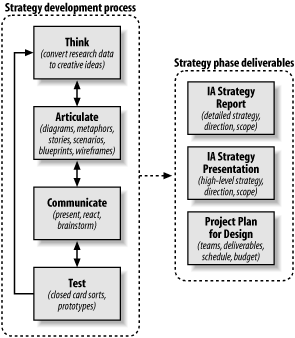Developing the Strategy
The transition from research to strategy involves a shift from a primary focus on process to a balance between process and product. Methodology is still important, but the work products and deliverables you create by applying that methodology move towards the center of attention.
Moving from a mode of absorption to one of creation is often a difficult transition for the information architect. No matter how much qualitative or quantitative research you’ve done, the development of an information architecture strategy is inherently a creative process, with all the associated messiness, frustration, pain, and fun.
Figure 11-2 presents an outline of the strategy development process and the resulting deliverables. Note the preponderance of arrows. This is a highly iterative and interactive process. Let’s take a look at the four steps along the path: think, articulate, communicate, and test (TACT).

Figure 11-2. Developing the information architecture strategy with TACT
Think
The human mind is the ultimate black box. Nobody really understands the process by which input (e.g., research data) is converted into output (e.g., creative ideas). Our advice is to use whatever works best for you. Some people think best by themselves, while taking a long walk or doodling on a pad of paper. Others think best in a group setting. The key is to recognize that you need to create some ...
Get Information Architecture for the World Wide Web, Second Edition now with the O’Reilly learning platform.
O’Reilly members experience books, live events, courses curated by job role, and more from O’Reilly and nearly 200 top publishers.

